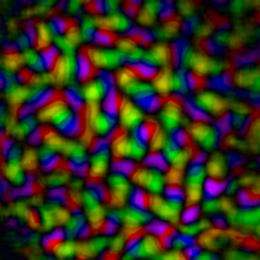Scientists show universality in the brain evolution

(PhysOrg.com) -- Scientists have uncovered a self-organizing biological principle in the brains of three very different, genetically diverse mammals -- but in all three they found the same mathematically precise "pinwheel" organization and orientation of neurons.
The scientists found that this visual cortex is self-organized, through neuronal activity and not through genes or environment (for example, ferrets raised in the dark still have this type of organization in their developing brains).
The most straightforward way to summarize the importance of this work is to say that this new study demonstrates that complex patterns of connections in the brain are capable of self-organizing with mathematical precision.
In fact, the notion that a complex pattern can appear in a dynamical system without a central authority or planner has been understood, for example, in the field of physics.
However, in the biological sciences, and in the field neuroscience in particular, self-organization as a developmental force seldom has been recognized. This study, of which Duke researcher Leonard White, PhD., in Duke neurobiology was an author, provides, if not the first, certainly the most well documented case for this agency in brain development. This precise structure arises both from ongoing activity and lateral interactions of the neurons as well as across a neural network.

The findings, published today in Science, may cause scientists to think in new ways about how such a complex system as the human brain with its 100 billion neurons, gets wired up to begin with, given the relative dearth of genes in the human genome and the relative lack of environmental experiences in the newborn that already has advanced neural architecture in its cerebral cortex.
This demonstration of self-organization in brain development may also have implications for rehabilitation in the brains of people recovering from neurological injury or disease. As neural circuits in the recovering brain reactivate growth programs that shaped development earlier in life, it seems likely that self-organization will continue to influence the architecture of neural circuits whenever they are plastic and capable of changing their strength and the distribution of their connections.
The challenge for future studies will be to understand how genetic instructions and early life experiences interact within a self-organizing network of brain cells, and how such interactions can be optimized to enhance function in normal developing brains, as well as in mature brains that have to adapt to injury and disease.
A word about the orientation of the neurons: The orientation is such that from any central neuron, the surrounding neurons are in a repeat pattern of orientation, and that central neuron is also a part of the repeat pattern in a neighboring pinwheel, with mathematical precision. Neurons respond to vertical, horizontal or oblique patterns to create the images that brains can assimilate and process as our 3-D world.
More information: Universality in the Evolution of Orientation Columns in the Visual Cortex, Matthias Kaschube et al., Science, November 5, 2010.
Provided by Duke University















